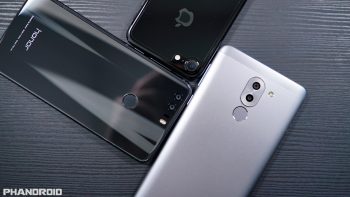
Camera shootout: Honor 6X vs iPhone 7, the results may surprise you
As technology evolves, our smartphones become more and more advanced. It’s something that doesn’t just benefit super expensive, top-tier devices like the iPhone, but lower-end devices as well. Looking at some of the more affordable Android devices, we’re finally seeing big improvements in areas like photography where cheaper handsets have traditionally struggled. This is something we saw first hand with the aggressively priced Honor 6X which — at $250 — not only takes a great photo, but comes equipped interesting hardware features like a dual-camera.
I’ve already talked about the camera on the Honor 6X in our in-depth review, but I wanted to see how it compared to some of the (much) higher priced competition. I can’t say I was expecting the Honor 6X and its 12MP camera to actually beat something like the iPhone 7 (one of the best performing mobile cameras around), I really just wanted to see who close it’d get.
Although the point of this comparison was to see how the Honor 6X stacked up to the iPhone 7, I decided to also throw in the Honor 8, the 6X’s more higher priced — and supposedly better equipped — sibling. After taking a handful of my sample photos, you might be surprised at the results. I know I certainly was.
Camera specs
- Honor 6X: 12MP (main) f/2.2 | Sony IMX386 sensor | 1.25 µm pixels
- iPhone 7: 12MP f/1.8 (OIS) | Sony Exmor RS sensor | 1.22 µm pixels
- Honor 8: 12MP (dual) f/2.2 | Sony IMX286 sensor | 1.25 µm pixels
Daylight and shade
Daylight is by far the easiest lighting environment to shoot with a smartphone. There’s plenty of light to hit their tiny sensors, meaning that this is really as good as it’s going to get. Although the sun was beginning to set when I began shooting, there was still plenty of light to work with as most photos were captured with the lowest possible ISO setting.
First thing you’ll notice is how the iPhone 7 tends to overexpose just about every shot. This is great for portraits where you typically want to brighten up human subjects as much as possible, but you can see how it blows out brighter areas of most every photo. It’s pretty obvious the Honor 6X and 8 meter the entire frame, while the iPhone is centered weighted. That’s why the exposure looks so much different between the devices, something that can be remedied on the Honor 6X simply by shooting in Pro mode.
In my review, I gave the Honor 6X loads of crap over its aggressive use of noise filtering to smooth out photos. What I didn’t consider (or perhaps just forgot) was how much the iPhone did the same thing with their photos, albeit not always to the same degree as the Honor 6X. Sometimes it’s a little more, other times it’s a little less, but in both cases finer details like the texture of rocks or fabrics are often times mistaken for noise and thus, smoothed out beyond recognition.
Honor 6X (left), iPhone 7 (right)
Even with all the post processing, I was surprised to find photos on the Honor 6X often times had more vibrant colors, cooler temperature, more accurate white balance, and didn’t blow out highlights the way the iPhone tended to do. If you zoom in close enough, you will notice an anti aliasing filter being used by the Honor 6X, but photos still displayed equal — and sometimes greater — detail than the iPhone 7. I almost couldn’t believe it.
Taking a look at the camera apps, the Honor 6X offers a much more robust set of tools for users to take advantage of. Aside from full manual controls in the Pro mode, the Honor 6X lets you quickly adjust the contrast, brightness, and saturation so your shots will always come out looking their best. It’s a level of control we don’t typically see in budget-friendly smartphones.
Low light (night time)
Just as I mentioned in my full review, low light is where everything falls apart. Simply put, the Honor 6X just isn’t equipped to tackle anything less than a sunny summer afternoon. The smaller f/2.2 aperture, lack of OIS, and slow shutter speed make low light shots extremely challenging.
The Honor 6X camera app also asks you to steady the shot “while it’s sharpening,” something that causes you to hold your breath when taking a shot. It’s something you really shouldn’t have to worry about when taking a photo.
Despite all of this, there was one shot where the Honor 6X came out on top (the Del Taco parking lot), but even for a night time shot, there was much more lighting than some of the other scenarios. In the end, low light shots often come out with less detail, noisy, devoid of color, and a bit washed out.
Other: Performance
Now that we’ve established the Honor 6X can hold its own against the iPhone 7 (at least in a daytime shootout), there are still some other extremely important aspects of a smartphone’s camera. By far my biggest gripe with taking photos on the Honor 6X is the extreme amount of shutter lag when taking photos. After the shutter button is pressed, it takes the phone almost a full second before it actually takes the shot. It may not sound like much, but move to quick or shake your hand before that shutter/save animation and it’ll result in a blurred image.
Another downside to the Honor 6X camera is the janky auto focus performance. It shouldn’t be this way. Both the Honor 6X and iPhone 7 utilize phase detection auto focus (PDAF) when snapping photos, with Huawei claiming super quick speeds of .3 seconds. Although this might be true in some cases, more than often we found the camera having difficulty focusing on close objects, especially during times when lighting wasn’t ideal. We know, it’s a $250 smartphone, so luxuries like laser auto focus couldn’t be afforded (you’ll have to pick up the Honor 8 for that), but the poor performance really puts a damper on the phone’s ability to take quick snap shots from the hip, or when trying to capture moving subjects.
It’s the above issues that really hold the Honor 6X’s camera from greatness and takes all the fun out of what would have otherwise been a fantastic little shooter. Even then, if you thought a $250 smartphone couldn’t possibly deliver equal — sometimes better — quality than the critically acclaimed iPhone 7, the Honor 6X takes your dollar and stretches it as far as it possibly can.

